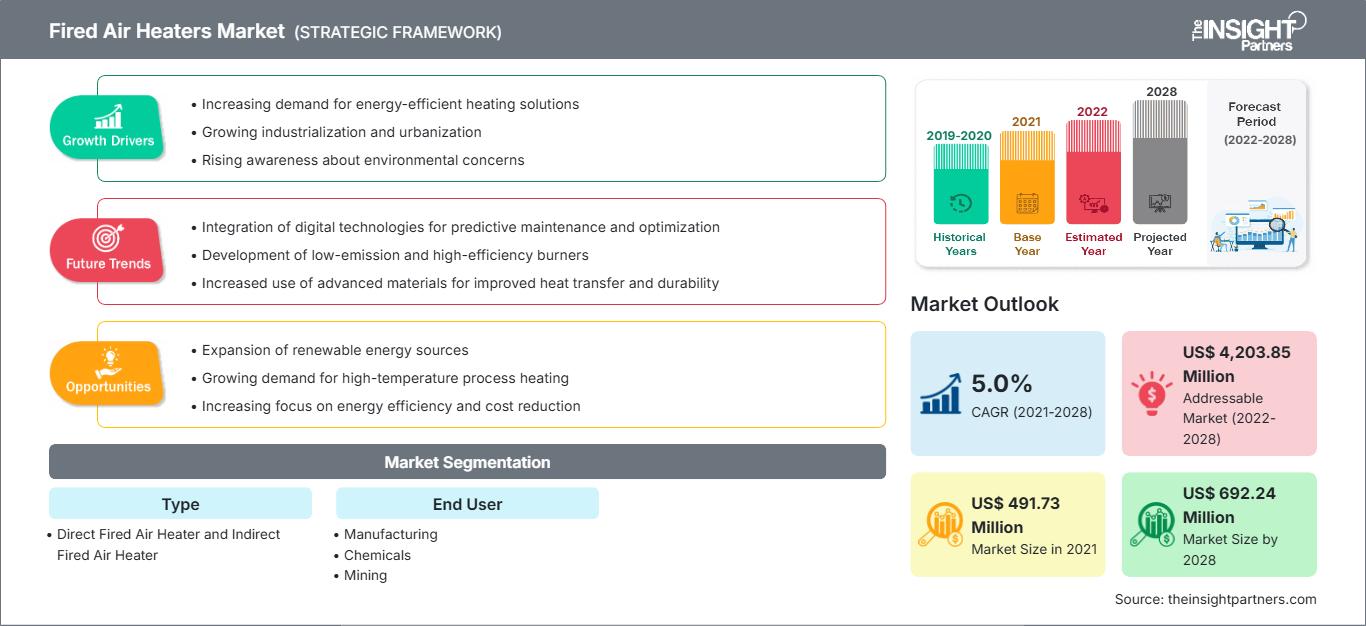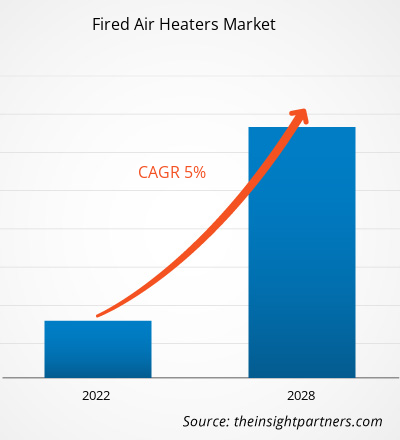Der Markt für befeuerte Lufterhitzer soll von 491,73 Millionen US-Dollar im Jahr 2021 auf 692,24 Millionen US-Dollar im Jahr 2028 wachsen; von 2021 bis 2028 wird mit einer durchschnittlichen jährlichen Wachstumsrate (CAGR) von 5,0 % gerechnet.
Die steigende Nachfrage nach Heizgeräten für industrielle Anwendungen in Schwellenländern ist eine wichtige Triebkraft für den Markt für befeuerte Lufterhitzer. Der Bedarf an befeuerten Lufterhitzern wird durch den gestiegenen Energiebedarf von Unternehmen in aufstrebenden Volkswirtschaften wie China, Indien, Japan und Brasilien getrieben. Aufgrund der kurzen Startzeit, des hohen Wirkungsgrads und der Zuverlässigkeit ist die Nachfrage nach befeuerten Lufterhitzern in der Fertigung, Stromerzeugung und Verarbeitung zudem gestiegen. Darüber hinaus sind erhöhte Investitionen in Stromerzeugungskapazitäten ein weiterer treibender Faktor für befeuerte Lufterhitzer. Aufgrund jahrzehntelanger Entwicklungen in der Produktproduktionstechnologie steigt der Bedarf an befeuerten Lufterhitzern weiterhin erheblich.
Befeuerte Lufterhitzer werden in der verarbeitenden Industrie häufig eingesetzt, um Gase oder Flüssigkeiten auf eine bestimmte Temperatur zu erhitzen. Darüber hinaus würde die Integration des Internets der Dinge (IoT) in befeuerte Lufterhitzer die Verbreitung befeuerter Lufterhitzer steigern und so das Marktwachstum im Prognosezeitraum ankurbeln.
Passen Sie diesen Bericht Ihren Anforderungen an
Sie erhalten kostenlos Anpassungen an jedem Bericht, einschließlich Teilen dieses Berichts oder einer Analyse auf Länderebene, eines Excel-Datenpakets sowie tolle Angebote und Rabatte für Start-ups und Universitäten.
Markt für befeuerte Lufterhitzer: Strategische Einblicke

-
Holen Sie sich die wichtigsten Markttrends aus diesem Bericht.Dieses KOSTENLOSE Beispiel umfasst Datenanalysen, die von Markttrends bis hin zu Schätzungen und Prognosen reichen.
Auswirkungen der COVID-19-Pandemie auf den Markt für befeuerte Lufterhitzer
Die COVID-19-Pandemie hat die Welt erheblich getroffen und erschüttert weiterhin mehrere Länder. Bis zum Ausbruch von COVID-19 verzeichnete die Branche der befeuerten Lufterhitzer ein erhebliches Produktionswachstum. Leider hat der COVID-19-Ausbruch die Nachfrage nach befeuerten Lufterhitzern in verschiedenen Branchen weltweit dezimiert, was sich in deutlich geringeren Auftragsvolumina bei den Flugzeugherstellern und damit in einer geringeren Anzahl von Produktionen widerspiegelt. Der Rückgang der Produktionsmengen wirkte sich negativ auf die Geschäfte verschiedener Komponentenhersteller und zugehöriger Technologien aus. Darüber hinaus demotivierte die Schwächung der Endverbraucher wie der Bau-, Automobil- und Bergbauindustrie den Markt. Daher wurden die Geschäfte der Marktteilnehmer für befeuerte Lufterhitzer durch die Destabilisierung der Produktion stark beeinträchtigt. Während der Verbreitung des COVID-19-Virus kam die gesamte Bauindustrie zum Stillstand und verfügte nur über minimale Ressourcen, um die Zukunft vorauszusehen. Mehrere Produktionseinheiten in den USA, Frankreich, Russland und China wurden vorübergehend stillgelegt, um die behördlichen Auflagen bezüglich Ausgangssperren und physischer Distanzierung einzuhalten. Die Baubranche verzeichnete einen Rückgang der Nachfrage nach neuen Projekten um 20–30 %. Darüber hinaus schwächte der Stopp der laufenden Bauprojekte den Markt weiter. Dieser Faktor wirkte sich negativ auf den Markt für befeuerte Lufterhitzer aus.
Markteinblicke zu befeuerten Lufterhitzern
Steigende Nachfrage nach Heizgeräten für industrielle Anwendungen
Kessel, Wärmepumpen und Öfen sind industrielle Heizgeräte, die in der Chemie-, Lebensmittel-, Bau-, Bergbau- und anderen Branchen zur Durchführung von Produktionsprozessen eingesetzt werden. Ein Kessel ist ein geschlossenes Gefäß, in dem Wasser oder eine andere Flüssigkeit erhitzt wird und Dampf entsteht, der anschließend unter hohem Druck zum Antrieb von Maschinen verwendet wird. Darüber hinaus ist eine Wärmepumpe ein Gerät, das Wärme zum Heizen oder Kühlen von Bereichen überträgt. Öfen sind zudem wesentliche Bestandteile einer Zentralheizung. In Amin- und Glykol-Reboilern müssen die korrosiven Schwefelwasserstoff- und Kohlendioxidgase aus dem Kohlenwasserstoffdampf entfernt werden, bevor die jeweiligen Brennstoffe in der Erdgas- und Rohölraffination gespeichert oder in die Pipeline eingeleitet werden können. Ähnlich wie Erdgasdampf wird Glykol verwendet, um Erdgas vor der Verteilung zu entwässern. Aufgrund der geringen Wartungskosten und der einfachen Handhabung wird dieser Erhitzertyp in der Erdgas-, Rohöl- und Prozessindustrie eingesetzt. In der chemischen Prozessindustrie werden befeuerte Erhitzer üblicherweise zum Erhitzen von Prozessflüssigkeiten und zur Dampferzeugung verwendet.
Befeuerte Erhitzer verbrauchen in der Prozessindustrie meist am meisten Energie. Für diese Untersuchung wird ein kastenförmiger Erhitzer mit vertikalen Rohren zum Erhitzen einer Kohlenwasserstoffflüssigkeit verwendet. Elutionserhitzer, eine spezielle Anwendung befeuerter Lufterhitzer, die ein einzigartiges Design erfordert, werden im Bergbau eingesetzt. Elution ist der Prozess der Trennung eines Stoffes aus einem anderen durch Waschen mit einem Lösungsmittel, fast immer unter Wärmezufuhr, in der analytischen und organischen Chemie. Mineralien wie Gold werden mithilfe von Austauschern gewonnen. Eine Mineral- und Lösungsmittellösung zirkuliert auf der einen Seite des Wärmetauschers, während sich auf der anderen Seite eine Wärmeübertragungsflüssigkeit – üblicherweise eine Thermoflüssigkeit – verteilt. In der Lebensmittelindustrie, insbesondere beim Frittieren von Kartoffeln, Snacks und vorgekochten Speisen – werden Wärmeträgerflüssigkeitserhitzer eingesetzt. In diesen zirkuliert die Thermoflüssigkeit, die in der Anlage erhitzt wird, und ihre Wärme wird über einen Wärmetauscher auf das Öl übertragen, das die Produkte darüber frittiert. Hier wurden einige Anlagen realisiert, ähnlich dem Elutionsprozess im Bergbau, bei dem das Frittieröl direkt durch den Kessel zirkuliert, der anschließend als befeuerter Lufterhitzer verwendet wird. Direkt befeuerte Erhitzer werden gelegentlich als Wärmeträgerflüssigkeitserhitzer oder indirekte Erhitzer in der petrochemischen Industrie eingesetzt. Die gute Leistung des Wartungsservices von direkt befeuerten Erhitzern in Chemieanlagen und Raffinerien und die einheitliche Ersatzteilversorgung sind die Hauptgründe für diese Akzeptanz, da Wärmeträgerflüssigkeitserhitzer für ihre Vorteile in ihren spezifischen Funktionen bekannt sind. Die steigende Nachfrage nach Heizgeräten für verschiedene industrielle Anwendungen treibt den Markt für befeuerte Lufterhitzer an.
Typbasierte Markteinblicke
Basierend auf dem Typ wurde der Markt für befeuerte Lufterhitzer in direkt und indirekt befeuerte Lufterhitzer unterteilt. Direkt befeuerte Lufterhitzer bieten eine sichere Möglichkeit, industrielle Umgebungen zu beheizen, indem sie ein geeignetes Luft-Brennstoff-Verhältnis (Erdgas oder Propan) aufrechterhalten. Das Gas wird in einem direkt befeuerten Heizgerät direkt zum Brenner geleitet, während der Luftstrom den notwendigen Sauerstoff für die Verbrennung liefert. Das Gas wird mit der Luft vermischt, die durch die Brennerblende geleitet wird. Der Brenner ist so eingestellt, dass er parallel zum Luftstrom brennt. Brennstoffverbrauch und Betriebskosten werden gesenkt, da etwa 100 % des Brennstoffs in Wärme umgewandelt werden.
Markt für befeuerte Lufterhitzer
Die Analysten von The Insight Partners haben die regionalen Trends und Faktoren, die den Markt für befeuerte Lufterhitzer im Prognosezeitraum beeinflussen, ausführlich erläutert. In diesem Abschnitt werden auch die Marktsegmente und die geografische Lage in Nordamerika, Europa, dem asiatisch-pazifischen Raum, dem Nahen Osten und Afrika sowie Süd- und Mittelamerika erörtert.Umfang des Marktberichts über befeuerte Lufterhitzer
| Berichtsattribut | Einzelheiten |
|---|---|
| Marktgröße in 2021 | US$ 491.73 Million |
| Marktgröße nach 2028 | US$ 692.24 Million |
| Globale CAGR (2021 - 2028) | 5.0% |
| Historische Daten | 2019-2020 |
| Prognosezeitraum | 2022-2028 |
| Abgedeckte Segmente |
By Typ
|
| Abgedeckte Regionen und Länder |
Nordamerika
|
| Marktführer und wichtige Unternehmensprofile |
|
Marktdichte von befeuerten Lufterhitzern: Auswirkungen auf die Geschäftsdynamik verstehen
Der Markt für befeuerte Lufterhitzer wächst rasant. Die steigende Nachfrage der Endverbraucher ist auf Faktoren wie veränderte Verbraucherpräferenzen, technologische Fortschritte und ein stärkeres Bewusstsein für die Produktvorteile zurückzuführen. Mit der steigenden Nachfrage erweitern Unternehmen ihr Angebot, entwickeln Innovationen, um den Bedürfnissen der Verbraucher gerecht zu werden, und nutzen neue Trends, was das Marktwachstum weiter ankurbelt.
- Holen Sie sich die Markt für befeuerte Lufterhitzer Übersicht der wichtigsten Akteure
Akteure auf dem Markt für befeuerte Lufterhitzer verfolgen Strategien wie Fusionen, Übernahmen und Marktinitiativen, um ihre Position auf dem Markt zu behaupten. Im Folgenden sind einige Entwicklungen der wichtigsten Akteure aufgeführt:
- 2018 erweiterte Allmand Bros. Inc. – ein 80 Jahre alter Hersteller von leistungsstarken tragbaren Baustellengeräten und eine Tochtergesellschaft der Briggs & Stratton Corporation – sein bestehendes Werk in Holdrege, Nebraska, um die Produktionskapazität zu steigern und die Markteinführungszeit mit neuen Technologien zu beschleunigen.
- 2018 eröffnete Pirobloc – ein führendes Unternehmen in der Entwicklung und Herstellung von Thermoölheizungen – eine Tochtergesellschaft in den USA. Pirobloc USA ist bereits Realität und voll betriebsbereit.
Der globale Markt für befeuerte Lufterhitzer wurde wie folgt segmentiert:
Markt für befeuerte Lufterhitzer – nach Typ
- Direkt befeuerte Lufterhitzer
- Indirekt befeuerte Lufterhitzer
Markt für befeuerte Lufterhitzer – nach Endverbraucher
- Herstellung
- Chemie
- Bergbau
- Lagerhäuser
- Öl und Gas
- Pharmazie
- Sonstige
Markt für befeuerte Lufterhitzer – nach Geographie
- Nordamerika
- USA
- Kanada
- Mexiko
- Europa
- Deutschland
- Frankreich
- Italien
- Großbritannien
- Russland
- Übriges Europa
- Asien-Pazifik (APAC)
- Australien
- China
- Indien
- Japan
- Südkorea
- Rest von APAC
- Naher Osten und Asien Afrika (MEA)
- Südafrika
- Saudi-Arabien
- VAE
- Rest von MEA
- Südamerika (SAM)
- Brasilien
- Argentinien
- Rest von SAM
Unternehmensprofile
- ALLMAND BROS., INC
- Exotherm Corporation
- Hastings HVAC, Inc.
- Pirobloc, SA
- SIGMA THERMAL, INC
- Stelter & Brinck, Ltd.
- Tamarack Industries
- Therm Dynamics
- Wacker Neuson SE
- Zeeco, Inc
- Historische Analyse (2 Jahre), Basisjahr, Prognose (7 Jahre) mit CAGR
- PEST- und SWOT-Analyse
- Marktgröße Wert/Volumen – Global, Regional, Land
- Branchen- und Wettbewerbslandschaft
- Excel-Datensatz
Aktuelle Berichte
Verwandte Berichte
Erfahrungsberichte
Grund zum Kauf
- Fundierte Entscheidungsfindung
- Marktdynamik verstehen
- Wettbewerbsanalyse
- Kundeneinblicke
- Marktprognosen
- Risikominimierung
- Strategische Planung
- Investitionsbegründung
- Identifizierung neuer Märkte
- Verbesserung von Marketingstrategien
- Steigerung der Betriebseffizienz
- Anpassung an regulatorische Trends






















 Kostenlose Probe anfordern für - Markt für befeuerte Lufterhitzer
Kostenlose Probe anfordern für - Markt für befeuerte Lufterhitzer